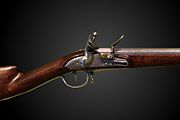| Revision as of 01:14, 6 July 2021 edit2600:1000:b05b:6613:ad41:31b5:d170:2bfc (talk) Undid revision 1032194006 by Loafiewa (talk)Tags: Undo Reverted Possible vandalism← Previous edit | Revision as of 01:14, 6 July 2021 edit undoLoafiewa (talk | contribs)Extended confirmed users, Pending changes reviewers, Rollbackers22,455 editsm Reverted edits by 2600:1000:B05B:6613:AD41:31B5:D170:2BFC (talk) to last version by LoafiewaTags: Rollback RevertedNext edit → | ||
| Line 6: | Line 6: | ||
| |name=Musket Modèle 1777 | |name=Musket Modèle 1777 | ||
| |type=] | |type=] | ||
| |origin=France | |origin=] | ||
| |era=] | |era=] | ||
| |platform=Individual | |platform=Individual | ||
| Line 13: | Line 13: | ||
| |production_date= 1777–1839 (all variants) | |production_date= 1777–1839 (all variants) | ||
| |manufacturer= Charleville armoury and others | |manufacturer= Charleville armoury and others | ||
| |service=] |
|service=] 1777–1840 | ||
| |used_by=], ], ], ], ], ], ], ], ], ], ], ], ], | |||
| |used_by=France, ], other ] of the ] | |||
| |wars= ], ], ], ], ], ], ], ], ], ], ], ], ], ], ], ] | |||
| |wars= ], ] and others in the European Theatre | |||
| |spec_type=] | |spec_type=] | ||
| |caliber= 17.5mm (.69 inch) ] | |caliber= 17.5mm (.69 inch) ] | ||
| Line 21: | Line 21: | ||
| |cartridge= 16.54 mm, 27.19 g lead ball<br />12.24 black-powder propellant | |cartridge= 16.54 mm, 27.19 g lead ball<br />12.24 black-powder propellant | ||
| |feed=] | |feed=] | ||
| |action=] | |action=]/] (conversion) | ||
| |rate=User dependent; usually 3 rounds a minute | |rate=User dependent; usually 2 to 3 rounds a minute | ||
| |velocity=Variable {{convert|420|m/s|ft/s|sp=us|abbr=on}} | |velocity=Variable {{convert|420|m/s|ft/s|sp=us|abbr=on}} | ||
| |sights =A ] cast into the upper barrel band | |||
| |range=Variable (50–100 yards) | |range=Variable (50–100 yards) | ||
| |weight= {{convert|4.75|kg|lbs}} | |weight= {{convert|4.75|kg|lbs}} | ||
| Line 31: | Line 32: | ||
| }} | }} | ||
| The ] '''Modèle 1777''', and later '''Modèle 1777 corrigé en l'an IX''' (Model 1777 corrected in the year |
The ] '''Modèle 1777''', and later '''Modèle 1777 corrigé en l'an IX''' (Model 1777 corrected in the year IX, or 1800 in the ]) was one of the most widespread weapons on the European continent. | ||
| It was part of a weapon family with numerous variants, e.g. for the ], ] and a ] for the ]. | It was part of a weapon family with numerous variants, e.g. for the ], ] and a ] for the ]. | ||
| Line 39: | Line 40: | ||
| == Other improvements == | == Other improvements == | ||
| The Musket was further improved in 1816 and 1822. | The Musket was further improved in 1816 and 1822. Many were converted from flintlock to ] in the mid-19th century. | ||
| == Impact == | == Impact == | ||
| Line 82: | Line 83: | ||
| ] | ] | ||
| ] | ] | ||
| ] | |||
| ] | ] | ||
Revision as of 01:14, 6 July 2021
Musket
The musket Modèle 1777, and later Modèle 1777 corrigé en l'an IX (Model 1777 corrected in the year IX, or 1800 in the French Revolutionary Calendar) was one of the most widespread weapons on the European continent.
It was part of a weapon family with numerous variants, e.g. for the light infantry, artillery and a musketoon for the cavalry.
Modèle 1777 corrigé en l' an IX
After the French Revolutionary Wars, first consul Napoleon Bonaparte commissioned a rework; some minor modifications on the lock, bayonet and stock resulted in 1800 in the "corrected" model, also called "Modèle 1777 corrigé".
Other improvements
The Musket was further improved in 1816 and 1822. Many were converted from flintlock to percussion cap in the mid-19th century.
Impact
7 million muskets were produced, including variants 1800 (an IX), 1816 and 1822, but not including muskets like the Austrian 1798 or the Prussian 1809, which were mere clones of the French 1777. Until World War I, no other firearm was produced in such large numbers.
Properly trained French infantry were expected to be able to fire three volleys a minute with the 1777. A trained infantryman could hit a man sized target at 80 yards but anything further required an increasing amount of luck and the musket became wildly inaccurate at long range. Compared to the British Brown Bess, it fired musket balls that fitted more tightly into the barrel resulting in a better accuracy but a lower rate of fire and more fouling issues.
The Grande Armée marched into the German countries and left approx. 750,000 muskets retreating in 1815; until about 1840, French weapons were used in Germany.
Details of the musketSee also
- Charleville musket for predecessors of the Modèle 1777
- Brown Bess – English musket, "counterpart" to the 1777 in the Napoleonic Wars
Literature
- Hans-Dieter Götz: Militärgewehre und Pistolen der deutschen Staaten 1800–1870, 2nd edition, Stuttgart, 1996, ISBN 3-87943-533-2 (in German)
References
- Moore, Richard Napoleonic Guide: Weapons of War: Infantry 2006
External links
| Preceded byCharleville musket | French Army rifle 1777–1826 |
Succeeded byDelvigne rifle 1826 |



